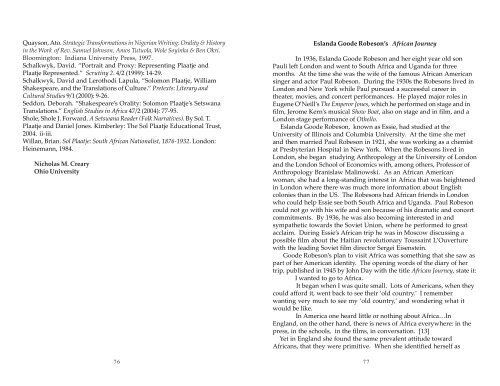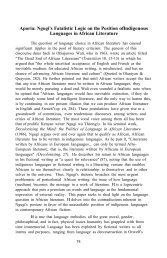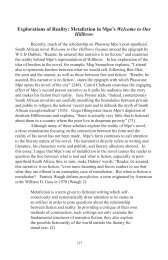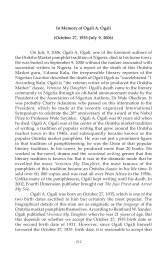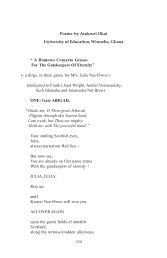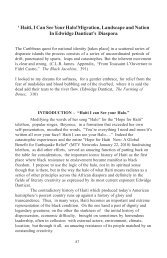Eslanda Goode Robeson's African Journey
Eslanda Goode Robeson's African Journey
Eslanda Goode Robeson's African Journey
Create successful ePaper yourself
Turn your PDF publications into a flip-book with our unique Google optimized e-Paper software.
Quayson, Ato. Strategic Transformations in Nigerian Writing: Orality & History<br />
in the Work of Rev. Samuel Johnson, Amos Tutuola, Wole Soyinka & Ben Okri.<br />
Bloomington: Indiana University Press, 1997.<br />
Schalkwyk, David. “Portrait and Proxy: Representing Plaatje and<br />
Plaatje Represented.” Scrutiny 2. 4/2 (1999): 14-29.<br />
Schalkwyk, David and Lerothodi Lapula, “Solomon Plaatje, William<br />
Shakespeare, and the Translations of Culture.” Pretexts: Literary and<br />
Cultural Studies 9/1 (2000): 9-26.<br />
Seddon, Deborah. “Shakespeare’s Orality: Solomon Plaatje’s Setswana<br />
Translations.” English Studies in Africa 47/2 (2004): 77-95.<br />
Shole, Shole J. Forward. A Setswana Reader (Folk Narratives). By Sol. T.<br />
Plaatje and Daniel Jones. Kimberley: The Sol Plaatje Educational Trust,<br />
2004. ii-iii.<br />
Willan, Brian. Sol Plaatje: South <strong>African</strong> Nationalist, 1876-1932. London:<br />
Heinemann, 1984.<br />
Nicholas M. Creary<br />
Ohio University<br />
76<br />
<strong>Eslanda</strong> <strong>Goode</strong> Robeson’s <strong>African</strong> <strong>Journey</strong><br />
In 1936, <strong>Eslanda</strong> <strong>Goode</strong> Robeson and her eight year old son<br />
Pauli left London and went to South Africa and Uganda for three<br />
months. At the time she was the wife of the famous <strong>African</strong> American<br />
singer and actor Paul Robeson. During the 1930s the Robesons lived in<br />
London and New York while Paul pursued a successful career in<br />
theater, movies, and concert performances. He played major roles in<br />
Eugene O’Neill’s The Emperor Jones, which he performed on stage and in<br />
film, Jerome Kern’s musical Show Boat, also on stage and in film, and a<br />
London stage performance of Othello.<br />
<strong>Eslanda</strong> <strong>Goode</strong> Robeson, known as Essie, had studied at the<br />
University of Illinois and Columbia University. At the time she met<br />
and then married Paul Robeson in 1921, she was working as a chemist<br />
at Presbyterian Hospital in New York. When the Robesons lived in<br />
London, she began studying Anthropology at the University of London<br />
and the London School of Economics with, among others, Professor of<br />
Anthropology Branislaw Malinowski. As an <strong>African</strong> American<br />
woman, she had a long-standing interest in Africa that was heightened<br />
in London where there was much more information about English<br />
colonies than in the US. The Robesons had <strong>African</strong> friends in London<br />
who could help Essie see both South Africa and Uganda. Paul Robeson<br />
could not go with his wife and son because of his dramatic and concert<br />
commitments. By 1936, he was also becoming interested in and<br />
sympathetic towards the Soviet Union, where he performed to great<br />
acclaim. During Essie’s <strong>African</strong> trip he was in Moscow discussing a<br />
possible film about the Haitian revolutionary Toussaint L’Ouverture<br />
with the leading Soviet film director Sergei Eisenstein.<br />
<strong>Goode</strong> Robeson’s plan to visit Africa was something that she saw as<br />
part of her American identity. The opening words of the diary of her<br />
trip, published in 1945 by John Day with the title <strong>African</strong> <strong>Journey</strong>, state it:<br />
I wanted to go to Africa.<br />
It began when I was quite small. Lots of Americans, when they<br />
could afford it, went back to see their ‘old country.’ I remember<br />
wanting very much to see my ‘old country,’ and wondering what it<br />
would be like.<br />
In America one heard little or nothing about Africa…In<br />
England, on the other hand, there is news of Africa everywhere: in the<br />
press, in the schools, in the films, in conversation. [13]<br />
Yet in England she found the same prevalent attitude toward<br />
<strong>African</strong>s, that they were primitive. When she identified herself as<br />
77
<strong>African</strong>, white people in London told her, “No, you’re not primitive, my<br />
dear,…you’re educated and cultured, like us” [15]. She immediately<br />
saw in this attitude the same patronizing racism that <strong>African</strong><br />
Americans heard from whites. She writes,<br />
It was the same old army game every Negro in America will<br />
recognize: the white American South says the Negro is ignorant and<br />
has a low standard of living; the Negro says the South won’t give him<br />
adequate schools or decent wages…White America generalizes in its<br />
mind about the primitiveness, ignorance, laziness, and smell of<br />
Negroes” [16].<br />
One of the elements that makes <strong>Goode</strong> Robeson’s journey to Africa<br />
relevant today is that she brings an <strong>African</strong> American’s perspective<br />
and background to South Africa. As the privileged wife of a celebrity,<br />
she traveled with and was hosted by white Europeans and South<br />
<strong>African</strong>s as well as black <strong>African</strong>s. Though her white hosts treated her<br />
as if she were more of an honorary white than a black person., she<br />
knew that she couldn’t count on that attitude from every white person<br />
she met. Her language, her clothing, her tickets for the ship, all marked<br />
her as a middle class westerner. Yet at the same time her identity as the<br />
wife of an <strong>African</strong> American celebrity and leader in the black<br />
community made it difficult for her to get a visa for South Africa. She<br />
writes: “the white people in Africa do not want educated Negroes<br />
traveling around seeing how their brothers live; nor do they want<br />
those brothers seeing Negroes from other parts of the world, hearing<br />
how they live” [18]. Nevertheless, she persevered and was admitted to<br />
South Africa because the English colonial authorities feared a scandal<br />
from the liberal side of their own press.<br />
On board the ship from London, <strong>Goode</strong> Robeson was befriended by<br />
quite a few white South <strong>African</strong>s returning from visits to Britain. She<br />
immediately understood the patronizing tone that they used to refer to<br />
their <strong>African</strong> servants: “I could almost feel I was a home again,<br />
listening to a white Southerner from our own Deep South. It think it<br />
will be easy for me to understand the South <strong>African</strong>s; their attitudes,<br />
especially their patriarchal attitudes, are entirely familiar” [30].<br />
<strong>Goode</strong> Robeson’s unique traveling position began when she was<br />
escorted off the boat by the prominent South <strong>African</strong> Anthropologist,<br />
Professor Isaac Schapera, a colleague of her professor in London. But<br />
before <strong>Eslanda</strong> and Pauli could get off the boat, they were besieged by<br />
newspapermen from Cape Town who wanted to know all about her<br />
prominent husband Paul Robeson who was then famous in London.<br />
They asked her why Robeson wasn’t with her, when he will give<br />
78<br />
concerts in South Africa, whether he’s expressed his views on racial<br />
segregation and discrimination in South Africa, why she has come<br />
there, whether she’s interested in local native conditions, and finally<br />
who will win the boxing match between Joe Louis and Max Schmeling.<br />
She was questioned as the wife of a black celebrity artist who had<br />
already become a spokesman for black rights in the US and Europe.<br />
<strong>Goode</strong> Robeson’s answers to these questions were as non-controversial<br />
as she could make them. She said that Paul Robeson had expressed his<br />
views on segregation and discrimination in general everywhere, but<br />
they did not know enough about specific problems in South Africa to<br />
express an intelligent view. When asked for her views about the<br />
<strong>African</strong>s’ primitive minds, she replied that <strong>African</strong>s she had met<br />
studying at universities in Europe had no trouble assimilating<br />
European thought and culture. She identified herself as a person of<br />
mixed racial background with much European and native American<br />
blood in her family who had always considered herself a Negro and<br />
had always been considered as a Negro by white Americans.<br />
Essie Robeson’s real introduction to South Africa begins when she<br />
meets <strong>African</strong>s who take her to the black communities in and around<br />
Cape Town. First she learns that in South Africa the terms colored and<br />
<strong>African</strong> do not refer to the same people. The term ‘colored’ means “any<br />
mixture of white blood with <strong>African</strong>, Indian, Chinese, or Malay blood.<br />
[36]. In 1936 there were about a half million colored people and seven<br />
million <strong>African</strong>s, “the indigenous native people,” in South Africa.<br />
While in Cape Town, <strong>Goode</strong> Robeson visited both the urban slum,<br />
District Six, as well as the <strong>African</strong> location of Langa which was seven<br />
miles outside of the city. Each one offered her a view of the worst<br />
aspects of South <strong>African</strong> society. Colored South <strong>African</strong>s were<br />
permitted to live in certain designated parts of cities, but <strong>African</strong>s<br />
were forbidden to live in colored sections and were forced to live in<br />
locations and reserves outside of the cities. They could not leave the<br />
reserves without written permission or a pass. <strong>African</strong>s walked seven<br />
miles from the Langa reserve to work in Cape Town and then back<br />
home again at night. The restrictions on <strong>African</strong> workers were so<br />
oppressive that <strong>Goode</strong> Robeson learned, when she reached<br />
Johannesburg, that there were 32,000 convictions for Pass Law offenses<br />
in 1930 in that one city. One of the most divisive aspects of South<br />
<strong>African</strong> racial policy was that the white government pitted the colored<br />
community against <strong>African</strong>s even though the so-called legal<br />
superiority of the formers’ social standing was minute, given the awful<br />
conditions that <strong>Goode</strong> Robeson saw in the urban colored quarter. In<br />
79
the mid-1930s, she lists the populations of South Africa as more than<br />
nine million people, divided into two million whites, comprising the<br />
ruling class, half a million colored people, a quarter of a million Asians,<br />
mostly Indians, and seven million <strong>African</strong>s.<br />
On her trip Essie was guided through South Africa by nurses, social<br />
workers, and even chiefs, who constituted an <strong>African</strong> middle class and<br />
elite. She was also hosted by white officials who treated her very well.<br />
She was a guest at an <strong>African</strong> wedding, school children came out to<br />
sing for her, and she was taken to the big <strong>African</strong> convention at<br />
Bloemfontein, where representatives of organizations from all over<br />
South Africa discussed how to improve conditions for people of color.<br />
In fact, traveling in South Africa reminded <strong>Goode</strong> Robeson of traveling<br />
in the deep South in America:<br />
You are passed from friend to friend, from car to<br />
car, from home to home, often covering thou<br />
sands of miles without enduring the inconve<br />
niences and humiliations of the incredibly bad<br />
Jim Crow train accommodations and lack of<br />
hotel facilities for Negroes. [65]<br />
<strong>Goode</strong> Robeson and her son were personally spared the experience of<br />
South <strong>African</strong> poverty that so moved her. As they were driven through<br />
the country they encountered countless <strong>African</strong> families on the road,<br />
walking endless miles between white farms that reflected the worst<br />
conditions of poverty. She writes,<br />
And always the heartbreaking sight of <strong>African</strong> families<br />
on the road on foot, trying somehow to escape from the<br />
slavery of these farms. The father often leads the small<br />
child by the hand, in front, followed by other children<br />
and the mother, who has all their worldly possessions<br />
on her head: perhaps a crude stove, blanket, a<br />
few clothes, a little food. [67]<br />
As <strong>Goode</strong> Robeson often compares South Africa to America, it is<br />
relevant to note that in the same year, 1936, American writers were<br />
describing similar scenes of rural poverty. James Agee and the<br />
photographer Walker Evans were recording their journey through<br />
rural white poverty in the American South in their powerful book Let<br />
Us Now Praise Famous Men. John Steinbeck was documenting the<br />
80<br />
struggles of migrant agricultural workers in his novels In Dubious Battle<br />
[1936] and The Grapes of Wrath [1939]. Major <strong>African</strong> American writers<br />
were also at work. Zora Neale Hurston would publish Their Eyes Were<br />
Watching God in 1937 and Richard Wright’s Uncle Tom’s Children,<br />
published in 1938, deals in part with <strong>African</strong> Americans leaving behind<br />
racism in the American South. Like Agee, <strong>Goode</strong> Robeson’s sympathy<br />
also extended across racial lines to poor whites. She writes about them<br />
with both identification and ambivalence:<br />
Occasionally on the roads we passed families of poor<br />
whites, usually Boers trekking in their oxcarts. They<br />
had make a failure of their last place and were moving<br />
on to find new land to waste and exhaust. Their faces<br />
were often wild, unkempt, and vacant, rather like<br />
roaming house animals. It is said they are lazy, shiftless,<br />
and ignorant, but these accusations are familiar to<br />
us. The same things are said about Negroes, to ease the<br />
consciences of those who grind us down. The same<br />
economic exploitation accounts for the desperate plight<br />
of Negroes and poor whites. [50]<br />
<strong>Goode</strong> Robeson here reflects a sharp consciousness of economic<br />
class divisions that she shares with her husband Paul. During the<br />
1930s both Paul and <strong>Eslanda</strong> had become deeply concerned about the<br />
threat of fascism in Europe. In fact, Paul Robeson went to Spain during<br />
its Civil War to sing to soldiers and audiences on the loyalist anti-<br />
Fascist side. Both Robesons were also becoming increasingly<br />
supportive of the society they saw developing in the Soviet Union. Her<br />
brothers were already living in Moscow and her mother joined them<br />
when <strong>Eslanda</strong> and Paul decided to send their son Pauli to school there<br />
after their <strong>African</strong> trip<br />
During the course of her journey, <strong>Goode</strong> Robeson discussed the need<br />
for improvement in black education with her <strong>African</strong> hosts, one of<br />
whom, Max Yergan, was an <strong>African</strong> American working for the YMCA in<br />
South Africa. On the subject of improvement in racial conditions,<br />
<strong>Goode</strong> Robeson held up the Soviet Union as a model. Her idealism is<br />
clearly evoked in the following excerpt:<br />
And the one hopeful light on the horizon—the<br />
exciting and encouraging conditions in Soviet Russia,<br />
where for the first time in history our raceproblem has<br />
been squarely faced and solved; where for the first time<br />
thefine words of the poets, philosophers, and well<br />
81
meaning politicians have been made a living reality.<br />
[47]<br />
As with her husband, <strong>Goode</strong> Robeson’s background in confronting<br />
American racism and then South <strong>African</strong> racism led her to<br />
idealistically embrace the hope represented by the new communist<br />
society in the Soviet Union. In the next twenty years, especially when<br />
the Cold War began after World War II, both Robesons, particularly<br />
Paul, would pay a heavy price for their sympathies toward Soviet<br />
communism. In 1953 <strong>Eslanda</strong> <strong>Goode</strong> Robeson would herself be called to<br />
testify before the Senate Investigating Committee and would there<br />
confront Senator Joseph McCarthy and argue him to a stand-off.<br />
As <strong>Goode</strong> Robeson sees the striking similarities between racial<br />
oppression of <strong>African</strong>s in South Africa and <strong>African</strong> Americans in the<br />
US, she begins to reflect on the view of <strong>African</strong>s widely held by most<br />
Americans, even <strong>African</strong> Americans. She writes, “I blush with shame<br />
for the mental picture my fellow Negroes in America have of our<br />
<strong>African</strong> brothers: wild black savages in leopard skins, waving spears<br />
and eating raw meat” [48]. She was undoubtedly thinking of the movie<br />
Sanders of the River that her husband Paul had recently made in England.<br />
In it he played a primitive <strong>African</strong> Chief named Bosambo who swears<br />
allegiance to the English colonizers of his imaginary <strong>African</strong> tribe. The<br />
film was intended to show that European domination was necessary to<br />
bring order and civilization to wild Africa. In fact, Paul Robeson made<br />
other movies in the 1930s about Africa in which he usually played the<br />
figure of a noble <strong>African</strong> chief who wears animal skins. The films<br />
feature charges of hundreds of <strong>African</strong> warriors carrying spears, yet<br />
also include popular songs to show off Paul Robeson’s singing voice.<br />
Almost none of these movies were successful artistically or<br />
commercially. None was as politically supportive of English<br />
colonialism as Sanders of the River, but they all presented the image of<br />
<strong>African</strong>s as either noble or threatening primitives. In her book, <strong>Goode</strong><br />
Robeson takes responsibility for perpetuating this stereotypical image<br />
of Africa that Americans were familiar with from watching Tarzan<br />
movies. But she insists that Paul Robeson will stop such portrayals in<br />
the future when she writes, “and we, with films like Sanders of the River,<br />
unwittingly helping to perpetuate this misconception. Well, there will<br />
be no sequel to Sanders” [48].<br />
Paul Robeson had always hoped to visit Africa himself. He did get<br />
to Cairo when he filmed the movie Jericho, or Dark Sands, after Essie’s trip.<br />
In 1937 he supported the International Committee on <strong>African</strong> Affairs,<br />
82<br />
an organization based in New York that was headed by Max Yergan,<br />
who had been one of Essie’s hosts in South Africa. In 1941, Paul became<br />
chairman of the Council on <strong>African</strong> Affairs, which was dedicated to the<br />
struggle for <strong>African</strong> freedom from European colonialism. The FBI<br />
considered the group to be a Communist front organization. Both Paul<br />
and <strong>Eslanda</strong> <strong>Goode</strong> Robeson became ardent participants in the anticolonial<br />
movement not just in Africa, but in India and other parts of the<br />
third world. Eventually they hailed the independence that new <strong>African</strong><br />
nations won from their European colonizers after World War II. There<br />
is no doubt that <strong>Eslanda</strong> <strong>Goode</strong> Robeson’s trip to Africa in 1936 had<br />
helped to form that support for <strong>African</strong> rights and independence.<br />
Works Cited:<br />
Robeson, <strong>Eslanda</strong> <strong>Goode</strong>: <strong>African</strong> <strong>Journey</strong>. New York: John Day, 1945.<br />
Duberman, Martin. Paul Robeson. New York: The New Press, 1989.<br />
Daniel Gover<br />
Kean University<br />
83


